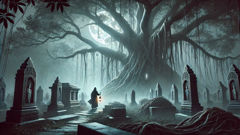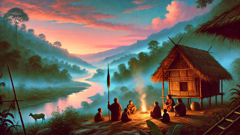Introduction
In the heart of the Visayas, where emerald rivers carve winding paths through ancient forests and mountains stand as silent witnesses to the passage of time, stories breathe with every whisper of wind and every ripple upon the water. Among these tales, none loom larger nor resonate deeper than the legend of Hinilawod—a song so vast, so rich, it has survived the centuries, cradled in the memory of the Suludnon people. This is a saga not simply of gods and mortals but of courage, love, and the unyielding spirit that binds families and communities together.
The world of Hinilawod is one where the sky and earth mingle freely, and mighty rivers serve as lifelines connecting realms both seen and unseen. At its center are three demigod brothers: Labaw Donggon, whose strength and desire are matched only by his insatiable curiosity; Humadapnon, wise and contemplative, a seeker of harmony and justice; and Dumalapdap, the youngest, whose fierce loyalty and determination blaze as brightly as his warrior’s heart. Born of a goddess, Alunsina, and a mortal chieftain, Datu Paubari, their lineage straddles both the celestial and earthly worlds, bestowing upon them powers—and responsibilities—beyond imagination.
The epic begins at the dawn of an era when ancient Panay was a land both untamed and enchanted. Tribes dwelled beneath the shade of towering trees, trading stories around the fire as the moon cast silvery patterns across the land. Yet even in this age of magic and harmony, shadows threatened. From the depths of the earth rose monsters and jealous spirits, while rival datu (chieftains) waged wars for honor, love, and pride. It is in this cauldron of mythic conflict that the three brothers undertake their separate but intertwined journeys, each driven by a quest that would test the very core of their being and shape the destiny of their people.
As the tale unfolds, the brothers will travel across mystical rivers, battle monstrous beasts, and outwit cunning sorcerers. They will risk their lives—and their hearts—in pursuit of love and the restoration of balance. Along the way, they meet goddesses with hair spun from moonlight, witches whose laughter echoes through bamboo groves, and warriors whose valor shines brighter than gold. Their paths, though different, are woven together by the unbreakable threads of kinship and destiny.
This is a story that calls to every listener—the child who dreams of adventure, the elder who remembers the old ways, and the seeker who wonders where courage comes from. Within these lines, the spirit of the ancient Visayan people endures, reminding us that even in the darkest times, heroes can rise from the river’s edge and shape the world anew.
Labaw Donggon’s Quest: Trials of Strength and Desire
Labaw Donggon, the eldest of Alunsina’s sons, was marked from birth by his restless spirit. With skin bronzed by the sun and eyes sharp as the talibong blade at his waist, he grew up among stories of distant lands and beautiful maidens whose names were spoken like prayers. As soon as he could wield a spear and command a boat, he set his heart upon adventure—yearning for challenges beyond his home in Halawod.
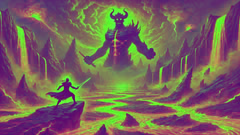
His first yearning was for Anggoy Ginbitinan, a maiden famed across the islands for her beauty and wisdom. With a heart pounding like the river in flood, Labaw Donggon carved a boat from a single mighty tree. As he paddled downriver, the forests parted before him, birdsong swirling overhead. Yet his journey was not unopposed. A host of river spirits, envious and capricious, conjured whirlpools and tangled his oars with vines. Undeterred, he invoked the blessing of his mother, whose voice whispered in the breeze, and pressed on. At last, he reached the land of Handug and found Anggoy Ginbitinan awaiting him atop a hill draped in wild orchids.
Their courtship was a contest of wit and resolve. Anggoy Ginbitinan, knowing the dangers that trailed men of power, set riddles before Labaw Donggon. With each riddle solved, a shadow lifted from her heart. When she finally accepted his hand, their union was celebrated by both mortals and spirits—their laughter echoing into the starry night. But Labaw Donggon’s hunger for challenge was unquenched. As stories of other legendary women reached his ears, his gaze turned to Anggoy Doronoon, whose kingdom lay beyond the wildest rivers and thickest jungles. Once more, he set forth—this time confronting monsters lurking beneath the water and sorcerers weaving spells of confusion. His prowess, both in battle and in heart, won over Anggoy Doronoon as well, and she joined his growing household.
Yet it was not enough. The tales of Abyang Alunsina’s rival, the fierce goddess Malitong Yawa Sinagmaling Diwata, beckoned from the dark edges of the world. Driven by both pride and an almost tragic yearning, Labaw Donggon sailed farther than any before him, to the land ruled by Saragnayan, the boar-faced god whose strength was matched only by his cruelty. Here, the air itself shimmered with danger. Saragnayan’s fortress was ringed by rivers of fire and guarded by shapeshifting beasts.
The battle between Labaw Donggon and Saragnayan was one for the ages. Steel clashed and magic sparked as the earth shook. For seven years they fought—neither yielding, neither aging, their struggle suspended in a realm outside of time. In the end, Saragnayan’s secret was revealed: his strength resided in a wild boar, hidden far from his body. With help from a wise babaylan (shaman) and the loyal spirits of his wives, Labaw Donggon slew the beast, breaking Saragnayan’s power. But victory came at a cost—exhausted and wounded, Labaw Donggon was imprisoned in a cave beneath the mountains, bound by the last of Saragnayan’s curses.
His absence cast a pall over Halawod. His wives mourned, their laments turning rivers brackish with sorrow. Yet even in his captivity, Labaw Donggon dreamed of home and love, his spirit unbroken.
Humadapnon’s Journey: Wisdom, Rescue, and the Bridge Between Worlds
While Labaw Donggon languished in darkness, Humadapnon, the middle brother, was restless with unease. Known for his thoughtful gaze and measured words, Humadapnon often found solace beside the riverside, seeking omens in the flight of birds or the whisper of bamboo leaves. But dreams haunted his sleep—visions of Labaw Donggon’s struggle, cries for help carried on the wind.
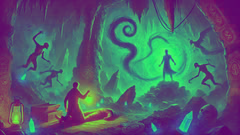
Determined to free his brother and restore balance, Humadapnon embarked on a journey that would test not just his courage, but the depth of his wisdom. His first stop was the home of Nagmalitung Yawa, a powerful babaylan with the gift of prophecy. She warned him of traps both magical and mundane, urging him to travel not by river, but by paths hidden beneath the earth and sky. Arming himself with enchanted amulets and the blessings of both ancestors and spirits, Humadapnon set forth. He crossed shadowy valleys where time ran slow and ascended mountains veiled in perpetual mist. Along the way, he faced cunning witches whose spells twisted memory and reason, but his steady heart and clever mind saw him through.
At last, guided by a magical bird and his own unflagging resolve, Humadapnon reached the mouth of the cave where Labaw Donggon was held. Here, he confronted Saragnayan’s lingering curses—phantoms and illusions that preyed on his deepest fears. Refusing to yield, Humadapnon chanted ancient invocations, breaking spell after spell until he found his brother weak but alive. Together they fought their way past the last of Saragnayan’s guardians, their bond unbreakable even in the face of death.
Their journey home was no less perilous. As they sailed upriver, the brothers were beset by jealous suitors of their wives, vengeful spirits, and natural calamities. Each trial brought them closer—not just as siblings, but as leaders destined to heal a fractured world. Upon their return to Halawod, there was celebration, but Humadapnon found no rest. He had glimpsed new threats—portents of disasters yet to come—and knew his work was far from over.
One night, guided by dreams, he set off once again—this time to rescue Nagmalitung Yawa herself, who had been captured by a coven of witches jealous of her power. This quest would force Humadapnon to bridge the realms of gods and men, negotiating with deities, outwitting monsters, and forging alliances with tribes across the islands. By his return, not only had he rescued Nagmalitung Yawa, but he had brought new wisdom to Halawod: unity was the only path to lasting peace.
Dumalapdap’s Valor: Brotherhood, Loyalty, and the Road Home
Dumalapdap, the youngest brother, was as wild as the river in monsoon and as steadfast as the mountains themselves. Where Labaw Donggon chased desire and Humadapnon sought wisdom, Dumalapdap embodied loyalty and heart—a spirit quick to laughter but quicker still to defend kin and land. When word reached him of his brothers’ ordeals, Dumalapdap wasted no time. With only his axe and a small band of loyal warriors, he set out to ensure their safe return and the survival of their people.
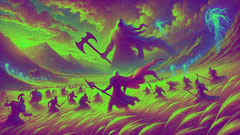
His journey began with a voyage upriver, facing waters swollen by unseen magic and forests alive with trickster spirits. In every village he passed, Dumalapdap gathered allies—old friends, grateful strangers, and even reformed foes who respected his open heart and fierce sense of justice. Where brute force failed, Dumalapdap turned to humor or cunning; when outnumbered, he inspired courage with stories of their ancestors’ valor.
But Dumalapdap’s greatest challenge came on the Plains of Binundaan, where he faced the monstrous Taghuyas, whose shadows stretched across half the land. The battle was both physical and spiritual—a contest of wills that threatened to break even Dumalapdap’s indomitable spirit. Yet, fueled by memories of childhood laughter and his brothers’ unwavering love, he refused to yield. After days of fierce struggle, Dumalapdap emerged victorious, earning not only freedom for captured villagers but also the respect of the land’s spirits.
With his band now swollen with allies, Dumalapdap pressed on toward Halawod. Along the way, he mediated disputes among rival chieftains, forging alliances that would strengthen their people for generations to come. When at last he reunited with Labaw Donggon and Humadapnon, their embrace was a thunderclap of joy—celebrated in song and feast by all who dwelled along the river.
Yet Dumalapdap’s journey was not just a return. He recognized that true strength lay in community—a lesson forged in hardship and tested in battle. When storms threatened to flood Halawod once again, Dumalapdap led efforts to build new dikes, plant sacred trees, and honor both gods and ancestors. His legacy was not just one of conquest, but of healing—a reminder that courage is most powerful when tempered by compassion.
Conclusion
The legend of Hinilawod endures not just in the telling but in the living spirit of Panay’s people. Labaw Donggon, Humadapnon, and Dumalapdap—each carved their own path through adversity, weaving courage, wisdom, and loyalty into the very fabric of their land. Their journeys remind us that heroism is never singular: it grows from love as much as from strength, from sacrifice as much as from victory.
In today’s world, where change and challenge remain constant companions, the story of these three brothers continues to resonate. Whether through literal battles or quiet acts of kindness, the lessons they learned—unity in diversity, hope in darkness, and faith in one another—echo across generations. The rivers still sing their names; the mountains remember their deeds.
And so, as evening settles over Panay and fires flicker in distant villages, elders gather children close and recount the legend once more. For as long as stories are told and remembered, the spirit of Hinilawod—the undying river—flows on.



